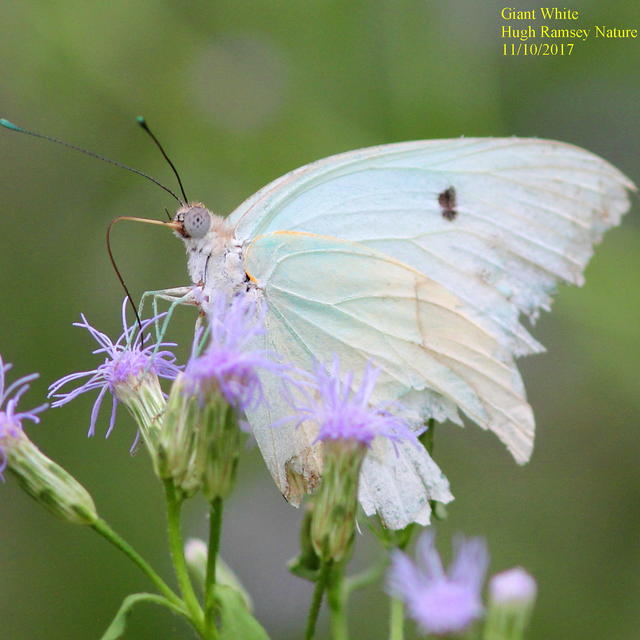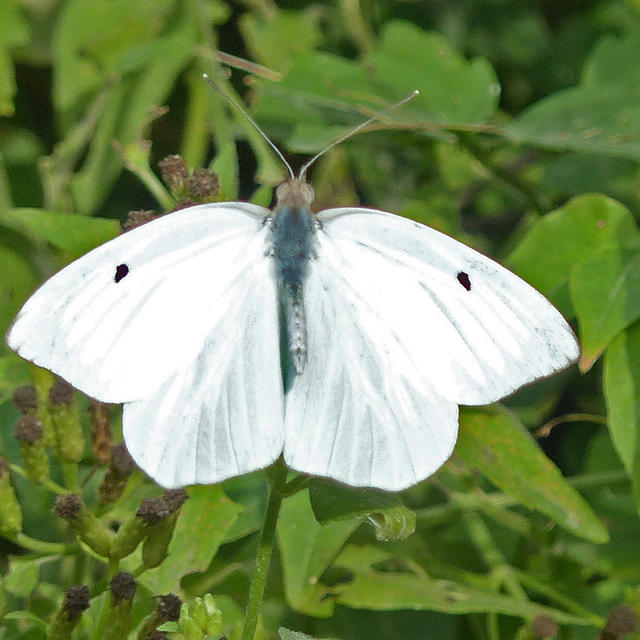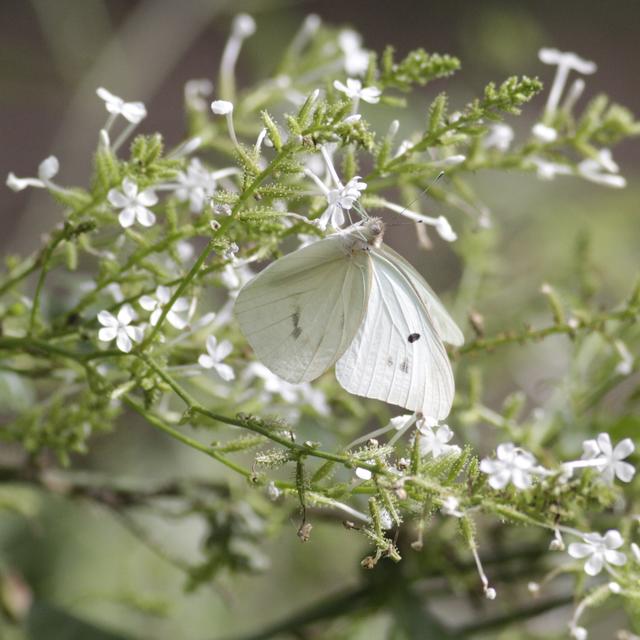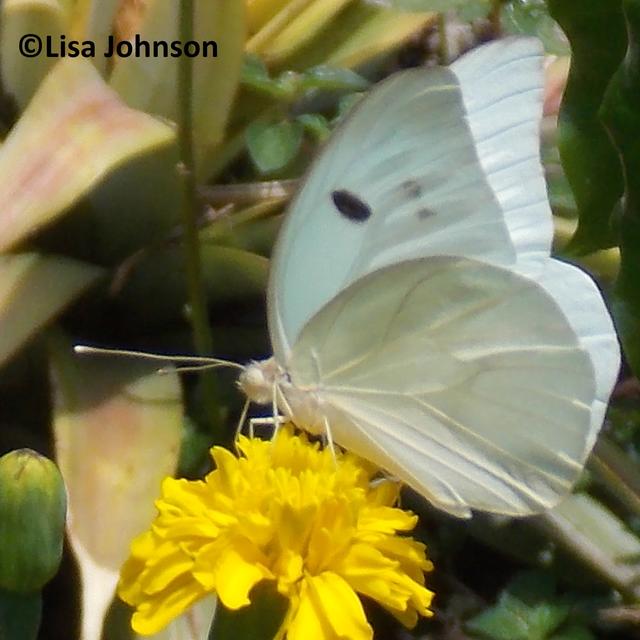Giant White
Ganyra josephina (Godart, 1819)
Family: Pieridae
Subfamily: Pierinae
Identification: Large. Cell of upper forewing of male contains prominent round black spot. Wet-season female has black cell spot and also diffuse black postmedian spots. Veins outlined with black near wing margins. Dry-season female not so prominently marked.
Wing Span: 2 7/8 - 3 3/4 inches (7.3 - 9.6 cm).
Life History: Female lays single eggs on older host plant leaves, which the caterpillars then eat.
Flight: From September-December in south Texas.
Caterpillar Hosts: Trees in the caper (Capparidaceae) family.
Adult Food: Flower nectar including lantana, eupatorium, and bougainvilla.
Habitat: Open, dry, subtropical forests.
Range: South from south Texas through Mexico and Central America. A rare stray to Kansas and New Mexico.
Conservation: Not required for periodic stray.
NCGR: G5 - Demonstrably secure globally, though it may be quite rare in parts of its range, especially at the periphery.
Management Needs: None noted.
Get your BAMONA Gear!
Please donate!
We depend on donations to keep Butterflies and Moths of North America freely available. We want to express our gratitude to all who showed their support by making a contribution this year. You can donate to support this project at any time.
Advertise with us!
Do you have a product or service that you think would interest BAMONA users? If you would like to advertise on this website, contact us by email, or use the contact form and select the "Advertising" category.
Verified Sightings
Displaying 25 - 48 of 55 verified sightings

Observation date: Oct 20, 2004
Submitted by: hydapse
Region: Hidalgo County, Texas, United States
Verified by: stomlins701
Verified date: Feb 12, 2019

Observation date: Nov 06, 2018
Submitted by: hiker96
Region: Hidalgo County, Texas, United States
Verified by: stomlins701
Verified date: Nov 21, 2018

Observation date: Nov 10, 2017
Submitted by: wallap74
Region: Cameron County, Texas, United States
Verified by: stomlins701
Verified date: Dec 31, 2017

Observation date: Dec 05, 2017
Submitted by: Paul Prappas
Region: Hidalgo County, Texas, United States
Verified by: stomlins701
Verified date: Dec 07, 2017

Observation date: Nov 20, 2013
Submitted by: ncrosbyrd
Region: Hidalgo County, Texas, United States
Verified by: stomlins701
Verified date: Jun 04, 2015

Observation date: Jun 17, 2014
Submitted by: LLJohnson
Region: Dominican Republic
Verified by: Doug Taron
Verified date: Aug 01, 2014

Observation date: May 06, 2014
Submitted by: LLJohnson
Region: Dominican Republic
Verified by: Doug Taron
Verified date: May 08, 2014

Observation date: Sep 02, 2008
Submitted by: plex1ppus
Region: Yucatan, Mexico
Verified by: John van Dort
Verified date: May 03, 2013

Observation date: Feb 14, 2013
Submitted by: Doug Taron
Region: Jalisco, Mexico
Verified by: Doug Taron
Verified date: Feb 19, 2013

Observation date: unknown
Submitted by: BAMONA
Region:
Verified by: BAMONA
Verified date: Sep 06, 2010
Observation date: Oct 17, 2007
Submitted by: legacy.reporter (Diane and Hugh Wedgeworth)
Region: Texas, Kenedy County, United States
Verified by: nick.grishin (Nick Grishin)
Verified date: Jan 08, 2008
Observation date: Oct 14, 2006
Submitted by: legacy.reporter (Mike Overton, Paul Opler)
Region: Tamaulipas, Mexico
Verified by: legacy.verifier (Mike Overton)
Verified date: Oct 01, 2007
Observation date: Oct 15, 2006
Submitted by: legacy.reporter (Mike Overton, Paul Opler)
Region: Tamaulipas, Mexico
Verified by: legacy.verifier (Mike Overton)
Verified date: Oct 01, 2007
Observation date: May 01, 2004
Submitted by: legacy.reporter (North American Butterfly Association (NABA) of South Texas))
Region: Hidalgo County, Texas, United States
Verified by: legacy.verifier (North American Butterfly Association (NABA) of South Texas))
Verified date: Jan 29, 2007
Observation date: Nov 02, 2004
Submitted by: legacy.reporter (North American Butterfly Association (NABA) of South Texas))
Region: Texas, Zapata County, United States
Verified by: legacy.verifier (North American Butterfly Association (NABA) of South Texas))
Verified date: Jan 29, 2007
Observation date: unknown
Submitted by: legacy.reporter
Region: Sinaloa, Mexico
Verified by: legacy.verifier
Verified date: Dec 31, 2004
Observation date: unknown
Submitted by: legacy.reporter
Region: Bee County, Texas, United States
Verified by: legacy.verifier
Verified date: Dec 31, 2004
Observation date: unknown
Submitted by: legacy.reporter
Region: Harris County, Texas, United States
Verified by: legacy.verifier
Verified date: Dec 31, 2004
Observation date: unknown
Submitted by: legacy.reporter
Region: Nuevo Leon, Mexico
Verified by: legacy.verifier
Verified date: Dec 31, 2004
Observation date: unknown
Submitted by: legacy.reporter
Region: Galveston County, Texas, United States
Verified by: legacy.verifier
Verified date: Dec 31, 2004
Observation date: unknown
Submitted by: legacy.reporter
Region: Bexar County, Texas, United States
Verified by: legacy.verifier
Verified date: Dec 31, 2004
Observation date: unknown
Submitted by: legacy.reporter
Region: Cameron County, Texas, United States
Verified by: legacy.verifier
Verified date: Dec 31, 2004
Observation date: unknown
Submitted by: legacy.reporter
Region: Tamaulipas, Mexico
Verified by: legacy.verifier
Verified date: Dec 31, 2004
Observation date: unknown
Submitted by: legacy.reporter
Region: Texas, San Patricio County, United States
Verified by: legacy.verifier
Verified date: Dec 31, 2004
- ‹ previous
- 2 of 3
- next ›





